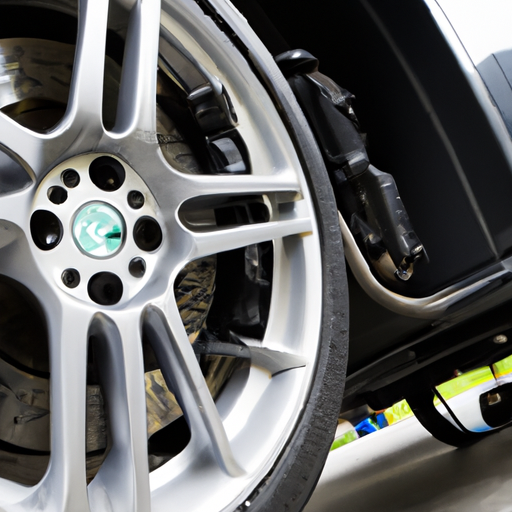When it comes to the fitment of wheels on your vehicle, several factors play a crucial role in determining the perfect match. These factors include the size, backspacing, offset, and bolt pattern of the wheels. By understanding how each of these elements influences the fitment, you can ensure that your wheels not only enhance the overall aesthetics of your vehicle but also provide a smooth and safe driving experience.

Tire Size
Overall Diameter
The overall diameter of a tire is an important factor when considering wheel fitment on your vehicle. It determines the total height of the tire and plays a crucial role in the overall performance and handling of your vehicle. A larger overall diameter can be achieved by increasing the tire’s wheel size or by choosing a tire with a larger aspect ratio.
Width
The width of a tire also affects wheel fitment. It refers to the distance between the outer edges of the tire’s sidewalls when mounted on a wheel. Choosing the right tire width is essential as it can impact the overall performance and aesthetic appeal of your vehicle. It is important to consider the manufacturer’s recommendations and the clearance within your vehicle’s wheel well when selecting the appropriate tire width.
Aspect Ratio
The aspect ratio of a tire is the ratio of its sidewall height to its width. This ratio determines the tire’s profile or how tall or short the sidewalls are. A lower aspect ratio indicates a shorter sidewall, often associated with high-performance tires, while a higher ratio results in a taller sidewall, commonly found in all-terrain or off-road tires. Selecting the right aspect ratio is crucial for wheel fitment as it affects the overall diameter and can impact the speedometer accuracy and clearance on your vehicle.
Wheel Size
Diameter
The diameter of a wheel refers to the distance across the center of the wheel, excluding the sidewalls. It plays a significant role in determining the overall look and stance of your vehicle. When selecting a wheel size, it is important to consider factors such as the available space within your vehicle’s wheel wells and any potential modifications to the suspension or fenders. Additionally, be mindful of the impact a larger wheel diameter can have on your vehicle’s performance and ride comfort.
Width
The width of a wheel is the measurement between the inner and outer edges. It is important to choose the correct wheel width to ensure proper tire fitment and performance. Width impacts the overall contact patch of the tire, which influences handling, cornering, and traction. Consider manufacturer recommendations and the desired tire size when selecting the appropriate wheel width for your vehicle.
Offset
The offset of a wheel determines the positioning of the wheel hub in relation to the centerline of the wheel. It is measured in millimeters and can be positive, negative, or zero. Positive offset indicates that the mounting surface is closer to the vehicle’s centerline, while negative offset means the mounting surface is closer to the outer edge. Choosing the right offset is crucial as it affects the clearance of the wheel and tire assembly, preventing interference with suspension components or fenders.
Bolt Pattern
The bolt pattern refers to the number of bolt holes on the wheel and the diameter of the circle they form. It is essential to choose a wheel with the correct bolt pattern to ensure proper fitment on your vehicle. Using a wheel with an incorrect bolt pattern can result in improper seating, causing vibrations, uneven tire wear, and potential safety hazards. Consult your vehicle’s owner’s manual or manufacturer recommendations to determine the correct bolt pattern for your vehicle.
Vehicle Suspension
Suspension Type
The type of suspension your vehicle has can influence wheel fitment. Different suspension setups, such as coilovers, air suspension, or stock suspension, may have different clearance requirements and limitations. It is crucial to consider the suspension type when selecting tire and wheel sizes, as improper fitment can lead to rubbing, bottoming out, or compromised handling and ride quality.
Suspension Modifications
Modifications made to your vehicle’s suspension can impact wheel fitment. Lowering or raising your vehicle’s ride height, adjusting camber, or installing aftermarket suspension components may require specific tire and wheel sizes to maintain proper fitment and performance. It is important to consult with reputable suspension experts or automotive professionals to ensure compatibility between your suspension modifications and desired wheel fitment.
Brake Clearances
Rotor Diameter
The diameter of your vehicle’s brake rotor should be taken into consideration when selecting wheel fitment. Larger brake rotors may require a larger diameter wheel to accommodate them, preventing potential interference between the caliper and the wheel spokes. It is crucial to verify the clearance between the brake rotor and the inner barrel of the wheel to avoid any potential rubbing or compromising braking performance.
Caliper Clearance
The clearance between your vehicle’s brake caliper and the inside of the wheel is another important factor in wheel fitment. Some high-performance brake calipers may have larger dimensions and require specific wheels with enough clearance to avoid interference. It is essential to verify the caliper clearance when selecting aftermarket wheels, ensuring they are compatible and provide adequate clearance for your vehicle’s brake system.

Fender Clearances
Fender Lip
The fender lip is the outer edge of the fender panel that extends over the tire. It is important to consider the clearance between the fender lip and the tire when determining wheel fitment. If the wheel and tire combination protrude too far or if the tires are too wide, they may rub against the fender lip, causing damage to both the tire and the fender. It is essential to maintain proper fender clearance to ensure safe and proper fitment of your chosen wheel and tire setup.
Inner Fender Liners
Inner fender liners are typically made of plastic or fabric and serve to protect the inner components of your vehicle’s wheel wells from debris and moisture. When selecting wheel fitment, it is important to consider the clearance between the inner fender liners and the wheels. If the wheels are too wide or have a larger diameter, they may come into contact with the inner fender liners, potentially causing damage or compromising the functionality of these protective components.
Vehicle Weight
Curb Weight
The curb weight of your vehicle refers to its total weight when it is fully equipped with all necessary fluids and a full tank of gas. It is an essential factor to consider when selecting wheel fitment as different wheel and tire combinations can impact the overall weight distribution of your vehicle. It is important to ensure that the chosen wheel and tire setup does not exceed the manufacturer’s recommended weight limits to maintain safe handling and performance.
Payload Capacity
The payload capacity of your vehicle refers to the maximum weight it can safely carry in addition to the curb weight. When considering wheel fitment, it is crucial to take into account the additional weight that may be added to your vehicle, such as passengers or cargo. The chosen wheel and tire setup should not exceed the payload capacity to avoid compromising the vehicle’s suspension, braking, and overall safety.

Manufacturer Recommendations
Owner’s Manual
Your vehicle’s owner’s manual is a valuable resource for determining the recommended tire and wheel specifications. It provides detailed information on the appropriate tire sizes, wheel sizes, offset, bolt pattern, and any additional recommendations or limitations specific to your vehicle. It is important to consult the owner’s manual to ensure the chosen wheel fitment adheres to the manufacturer’s guidelines and maintains the vehicle’s warranty and safety.
Tire and Wheel Specifications
In addition to the owner’s manual, the manufacturer may provide specific tire and wheel specifications for your vehicle. These specifications can often be found on the manufacturer’s website or by contacting their customer service. By following the recommended tire and wheel specifications, you can ensure proper fitment, optimal performance, and compatibility with your vehicle’s suspension, brake systems, and overall design.
Aftermarket Options
Wheel Spacers
Wheel spacers are aftermarket components designed to increase the distance between the wheel hub and the mounting surface. They are used to create additional clearance between the wheel and suspension components, allowing for a wider wheel and tire fitment. It is important to choose high-quality wheel spacers that are specifically designed for your vehicle and provide the necessary clearance without compromising safety or causing vibrations.
Wheel Adapters
Wheel adapters, similar to wheel spacers, are used to change the bolt pattern of your vehicle’s wheels. They allow for the installation of wheels with a different bolt pattern than what is originally equipped on your vehicle. Wheel adapters can be useful when wanting to fit custom wheels or wheels from a different vehicle onto your car. It is essential to choose wheel adapters that are properly engineered, ensuring proper fitment, strength, and safety.

Budget Considerations
Cost of Wheels and Tires
When considering wheel fitment, it is important to factor in the cost of both wheels and tires. Depending on the desired size, brand, and quality, the cost of wheels and tires can vary significantly. It is crucial to set a budget and explore different options that fit within your financial limitations. However, it is essential to prioritize quality and safety over cost to ensure a durable and reliable wheel and tire setup.
Installation and Alignment Costs
In addition to the cost of wheels and tires, it is important to consider the installation and alignment costs. Proper installation ensures the correct mounting and balancing of the wheels and tires, preventing vibrations and potential safety issues. Wheel alignment is also crucial to maintain optimal handling, tire wear, and overall vehicle performance. It is recommended to consult with reputable automotive professionals who specialize in wheel fitment to ensure proper installation and alignment of your chosen setup.
Aesthetics
Wheel Design
The design of the wheel plays a significant role in the overall aesthetics of your vehicle. Different wheel designs, such as multi-spoke, mesh, or split-spoke, can complement the style and enhance the look of your vehicle. When selecting a wheel design, consider your personal preferences and the desired aesthetic appeal. It is crucial to choose a design that complements your vehicle’s body style and matches your overall vision.
Finish Options
Wheel finishes, such as chrome, polished, painted, or machined, can add a unique touch to your vehicle’s appearance. The choice of wheel finish should complement the vehicle’s color and overall style. It is important to consider the durability and maintenance requirements of different finishes. Some finishes may require regular cleaning and extra care to prevent damage from harsh weather conditions. Select a wheel finish that not only enhances the aesthetics but also provides long-lasting durability and ease of maintenance.
In conclusion, several factors influence wheel fitment on your vehicle. From tire size, wheel size, and vehicle suspension to brake clearances, fender clearances, and vehicle weight, each element plays a crucial role in determining the appropriate wheel and tire setup. It is important to consider manufacturer recommendations, consult your vehicle’s owner’s manual, and seek professional advice to ensure safe and optimal fitment. By carefully choosing the right combination of wheels and tires while considering aesthetics, budget, and performance, you can enhance the look and performance of your vehicle while maintaining safety and reliability.


